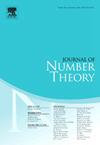爱森斯坦素数下Rankin-Selberg积的Iwasawa理论
IF 0.7
3区 数学
Q3 MATHEMATICS
引用次数: 0
摘要
设p是奇素数,f是权k的p-ordinary新形式h是权k的归一化反转p-ordinary Hecke特征形式。本文研究了f与h的Rankin-Selberg积的p进l函数和p∞-Selmer群,其条件是p是h的爱森斯坦素数,即h在p下的剩余伽罗瓦表示是可约的。我们证明了p进l函数和f,h的Rankin-Selberg积的p∞-Selmer群的特征理想在Iwasawa代数中产生相同的理想模p,即f⊗h的Rankin-Selberg Iwasawa主猜想保持模p。作为对我们结果的应用,我们明确地描述了几个例子,其中上述同余成立。本文章由计算机程序翻译,如有差异,请以英文原文为准。
Iwasawa theory for Rankin-Selberg product at an Eisenstein prime
Let p be an odd prime, f be a p-ordinary newform of weight k and h be a normalized cuspidal p-ordinary Hecke eigenform of weight . In this article, we study the p-adic L-function and -Selmer group of the Rankin-Selberg product of f and h under the assumption that p is an Eisenstein prime for h i.e. the residual Galois representation of h at p is reducible. We show that the p-adic L-function and the characteristic ideal of the -Selmer group of the Rankin-Selberg product of generate the same ideal modulo p in the Iwasawa algebra i.e. the Rankin-Selberg Iwasawa main conjecture for holds mod p. As an application to our results, we explicitly describe a few examples where the above congruence holds.
求助全文
通过发布文献求助,成功后即可免费获取论文全文。
去求助
来源期刊

Journal of Number Theory
数学-数学
CiteScore
1.30
自引率
14.30%
发文量
122
审稿时长
16 weeks
期刊介绍:
The Journal of Number Theory (JNT) features selected research articles that represent the broad spectrum of interest in contemporary number theory and allied areas. A valuable resource for mathematicians, the journal provides an international forum for the publication of original research in this field.
The Journal of Number Theory is encouraging submissions of quality, long articles where most or all of the technical details are included. The journal now considers and welcomes also papers in Computational Number Theory.
Starting in May 2019, JNT will have a new format with 3 sections:
JNT Prime targets (possibly very long with complete proofs) high impact papers. Articles published in this section will be granted 1 year promotional open access.
JNT General Section is for shorter papers. We particularly encourage submission from junior researchers. Every attempt will be made to expedite the review process for such submissions.
Computational JNT . This section aims to provide a forum to disseminate contributions which make significant use of computer calculations to derive novel number theoretic results. There will be an online repository where supplementary codes and data can be stored.
 求助内容:
求助内容: 应助结果提醒方式:
应助结果提醒方式:


